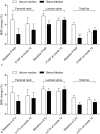Clinical characteristics associated with bone mineral density improvement after 1-year alendronate/vitamin d3 or calcitriol treatment: Exploratory results from a phase 3, randomized, controlled trial on postmenopausal osteoporotic women in China
- PMID: 30075569
- PMCID: PMC6081166
- DOI: 10.1097/MD.0000000000011694
Clinical characteristics associated with bone mineral density improvement after 1-year alendronate/vitamin d3 or calcitriol treatment: Exploratory results from a phase 3, randomized, controlled trial on postmenopausal osteoporotic women in China
Abstract
Baseline and on-treatment characteristics, including age, obesity, calcium intake, and bone turnover markers, may predict the bone mineral density (BMD) response in women with postmenopausal osteoporosis (PMO) to 1 to 2 years of antiresorptive therapy and/or vitamin D supplementation. This study aimed to explore clinical characteristics associated with 12-month BMD improvement in Chinese women with postmenopausal osteoporosis (PMO).In this post hoc analysis of a previous phase 3 multicenter, randomized controlled trial, Chinese PMO women who were treated with once weekly alendronate 70 mg/vitamin D3 5600 IU (ALN/D5600) or once daily calcitriol 0.25 mcg, and had measurements of 1-year lumbar spine BMD (LS-BMD) and on-treatment bone turnover markers (BTMs) were included in the analysis.In Chinese PMO patients on ALN/D5600, 1-year LS-BMD change was negatively correlated with age (β = -0.00084, P < .01), dietary calcium (β = -0.0017, P = .07), and procollagen type 1 N-terminal propeptide (P1NP) change at month 6 (β = -0.000469, P = .0016), but positively with body mass index (BMI) (β = 0.00128, P = .08); baseline P1NP above the median was associated with a significantly greater BMD percentage change at the lumbar spine (P = .02) and the total hip (P = .0001). In the calcitriol group, a significant 1-year LS-BMD increase was associated with BMI (β = 0.0023, P = .02), baseline P1NP (β = 0.00035, P = .0067), history of prior vertebral fracture(s) (β = 0.034, P < .0001) and baseline serum 25(OH)D level (β = -0.00083, P = .02).The presented findings from Chinese postmenopausal osteoporotic women suggested clinically meaningful baseline and on-treatment characteristics predicting BMD improvement after 1 year of ALN/D5600 treatment, which differed from calcitriol treatment with baseline identifiable associations. The study remained exploratory and further accumulation of evidence is needed.
Figures


References
-
- Cummings-Vaughn LA, Gammack JK. Falls, osteoporosis, and hip fractures. Med Clin North Am 2011;95:495, x–506, x. - PubMed
-
- Jackson RD, Mysiw WJ. Insights into the epidemiology of postmenopausal osteoporosis: the Women's Health Initiative. Semin Reprod Med 2014;32:454–62. - PubMed
-
- Wang Y, Tao Y, Hyman ME, et al. Osteoporosis in China. Osteoporos Int 2009;20:1651–62. - PubMed
-
- Zhen D, Liu L, Guan C, et al. High prevalence of vitamin D deficiency among middle-aged and elderly individuals in northwestern China: its relationship to osteoporosis and lifestyle factors. Bone 2015;71:1–6. - PubMed
Publication types
MeSH terms
Substances
LinkOut - more resources
Full Text Sources
Other Literature Sources
Medical

